Posted on July 15, 2016 at 11:11 am
How Wiesel’s “tattoo” looks from where I’m sitting
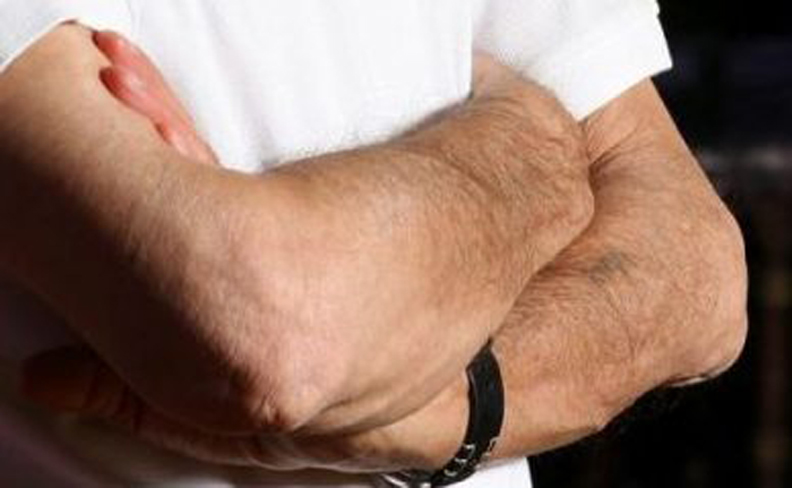
Enlarged close-up of Elie Wiesel’s arms in a 2006 photograph by Eyal Toueg, first published in Haaretz (see previous article).
by Carolyn Yeager
copyright 2016 Carolyn Yeager
It’s pretty pathetic to be confronted with a picture like the above, and expected to acknowledge that it is Elie Wiesel’s Auschwitz tattoo that I have been asking to see for six years now. Once again, the best suggestion I have for magnifying it is to click on it to get the image page, then hit the plus key up to 8 times while holding down the Ctrl key. The image stays sharp while being greatly enlarged. What do you see? I invite all the amateur, and maybe professional sleuths out there to do their thing.
Wiesel has been hiding this faded-out, so-far-undecipherable spot on his arm for 70 years, and now that he’s safely buried and completely inaccessible, Haaretz, the Israeli newspaper that broke the story of Wiesel’s death, is beginning to reveal that arm. At least, that’s how it looks from where I’m sitting.
To the naked eye, it appears to be a bruise on the arm. Upon magnification, we can barely make out what appear to be numbers, but it’s not at all clear what numbers they are. I think I see a couple but I’m not going to reveal what they are because I want a better image – and think we all deserve one. The dark and light lines made by his arm hair create a confused mess, visually. What we need are more high-resolution photographs like this one, preferably with a straight-on view of the arm. The photographer Eyal Toueg must have taken many shots on this day in 2006 and he would have all the negatives. It is his responsibility to publish them all, every one that shows Wiesel’s left arm, but he is probably Israeli and is under the dictate of higher ups. Someone else may have bought all the negatives. Maybe Haaretz owns them.
As it is, we are left with many questions – such as, why has Wiesel refused to show his supposed faded tattoo over the years? Is it because it’s unreadable? If he revealed it, the public would question it – or at least sceptics would – and he was not prepared to answer questions. Probably, if there were journalists who took a genuine unflinching investigative approach, he would have been forced to discuss it, but none did. The efforts of Jean Robin of Enquete & Debat website to encourage such an investigation show conclusively that lack of journalistic willingness.
Has it been kept hidden because it is not A-7713? Could that be why whatever was there has been defaced or somehow unnaturally/synthetically faded or smeared? I cannot find any example of an Auschwitz tattoo that looks like his does.
Is it because it is something he put on his arm himself when he was a youth in France? In this 1945 b&w photograph (below) taken at the French orphanage for Jewish boys we see what looks like an Auschwitz tattoo, albeit a tiny one, on Wiesel’s arm in the same place we see the dark spot in the 2006 photo.
The ready conclusion is that it’s his Auschwitz tattoo A-7713. But we can’t make it out at all! It’s already faint in 1945 and when I magnify it, no part of it is recognizable.
It’s also interesting that this photograph was posted on the Internet by French Jew Loupi Smith, but it doesn’t seem to be in the US Holocaust Memorial Museum online collection (where it is hopeless to try to view their Wiesel photo collection, anyway; they obviously don’t want you to see it). Nor is it in the Yad Vashem photo collection under Elie Wiesel – in fact, they have only 3 photographs with Wiesel in them – all the rest are aerial views of Auschwitz-Birkenau! Really weird. I think this decision to withhold pictures of Wiesel can only have come from Wiesel himself. In my opinion, though, the above is definitely a photo of Elie Wiesel in 1945 in France.
Our next pictures are these two, which show the same mark on the arm in the same place, but both are still completely unreadable as numbers. I assume these pics are from the same 2006 photo shoot that produced our newest picture, which is a much better high-resolution image. We can see sharp detail, but the “tattoo” is still not decipherable. It’s a really bad “tattoo!” The problem does seem to be with the “tattoo,” not the photograph. It is just very faint.
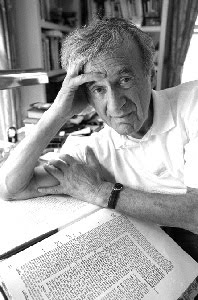
When this 2006 image is magnified, the possible “tattoo” is seen only as a darker spot, not recognizable as a number.

This image was also uploaded by Loupi Smith, but where did he get it? It’s obviously from the same 2006 photo shoot by Eyal Toueg.
Now take a look at another man’s equally hairy arm below– he is Erwin Farkas who was transported to Auschwitz from Hungary in 1944 at the age of 14. His number, A-7899, is only 186 digits beyond A-7713 – they are in the same time frame. His tattoo is faded and a little blurred, but still legible. There is no discoloration of the surrounding skin and the numbers are definitely blue. In fact, all the tattoos that one sees on the Internet are in this good of shape or better (many are fake though).
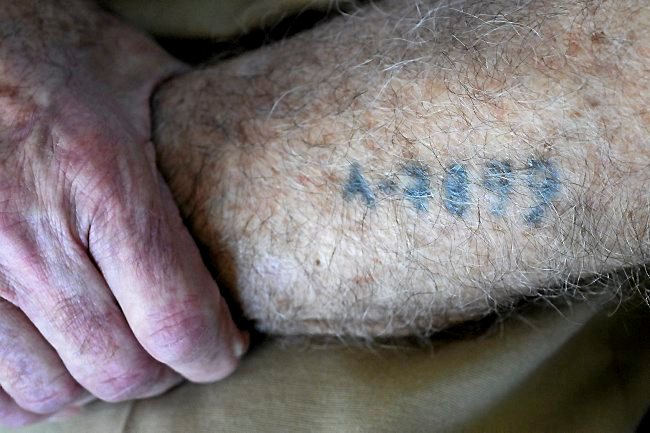
Erwin Farkas displays the Auschwitz tattoo A-7899 on his arm.
What happened to Wiesel’s that it is almost impossible to see? Only Wiesel could answer that – or would – so it’s clear that he didn’t want to since he didn’t allow the higher quality picture at the top of this page be published during his lifetime.
In the “court of public opinion” and morally (if not legally), there is no excuse for Elie Wiesel to have been given the velvet-glove treatment he was by journalists and by historians. He had a duty to show the tattoo he said was on his arm and allow it to be photographed. He had a moral duty to prove that it was what he said it was—A-7713. His failure to do that over the course of many years makes him, and the mainstream media that enabled him, guilty of worse than negligence — they are guilty of withholding evidence. The media and academics are more guilty than Wiesel himself because Wiesel has to be given the right not to incriminate himself.
But morally, Wiesel is guilty of withholding evidence that was available all the time.
Above, I used the words “higher quality” but if all these pictures of Wiesel in the white knit short-sleeve shirt were taken on the same day by a professional photographer (which it makes sense that they were) then they should all be of similar high quality. And since we can’t make out the numbers on any of the three, it can only be that it’s the fault of the ‘tattoo,’ not the photography.
I don’t believe this latest-to-be-revealed photograph from 2006 is photo-shop in any way. I do believe this is what Wiesel has on his arm, which he always claimed was A-7713. If it turned out to be A-7713, I would’t be upset in the least because all I’ve ever wanted was the truth about Elie Wiesel. But there will be questions and I will have a very hard time reconciling myself to the idea that the SS camp authorities could have made up a registration card for a 15 year old boy with the information that he was a 31-year-old man with the occupation of Schlosserlehring (Locksmith) – and never correcting it – allowing this boy to enter Buchenwald with that identification. No, it would be very hard to believe that.
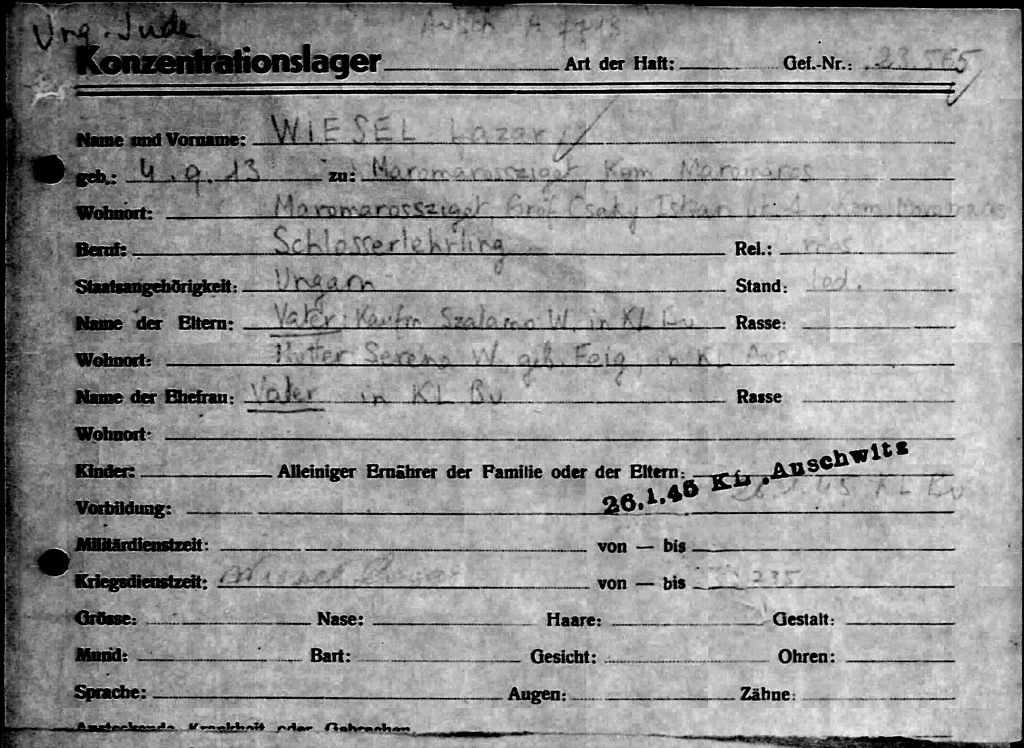
The Buchenwald file card that shows Lazar Wiesel, born Sept. 4, 1913 (age 32), occupation locksmith, A-B prisoner number A-7713, arrived in a transport that left Auschwitz on Jan. 26, 1945.
So I can only hope that more of these photos by Eyal Toueg will be published. Because as it stands now, Elie Wiesel’s tattoo claims still don’t pass the most elementary test – that of what the heck is the number!
Categories Featured | Tags: Auschwitz tattoos, Elie Wiesel, Erwin Farkas, Lazar Wiesel
Leave a Reply
By submitting a comment here you grant Elie Wiesel Cons the World a perpetual license to reproduce your words and name/web site in attribution. Inappropriate or irrelevant comments will be removed at an admin's discretion.

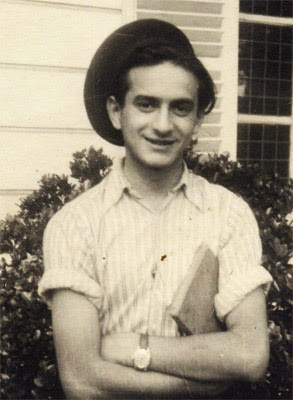

12 Comments to How Wiesel’s “tattoo” looks from where I’m sitting
by Franklin Ryckaert
On July 15, 2016 at 3:14 pm
It is clear that Elie Wiesel was a con-man. The contents of his books alone prove that. From the testimony of Nikolaus Miklos Gruner it is also clear that Elie Wiesel had stolen the identity from Lazar Wiesel, a man far older than Elie Wiesel himself. (see You Tube video : Elie Wiesel, the fake survivor of Auschwitz).
But what about that tattoo? It cannot be the original number A-7713, because that was from Lazar Wiesel. If Wiesel would have falsified that tattoo number while he had none, he would have done better work. I think there was already a genuine number tattooed on his arm, but a number different from A-7713. In his youthful hubris he tried to erase it and replace it with number A-7713, but that failed. To avoid a further painful operation in which the original tattoo would need to be erased and a new number engraved, Wiesel left it as it was. Hence his reluctance to show his tattoo clearly, allowing only photographs from a safe distance, with the result that only a stain is visible that looks like a number but is unreadable and certainly doesn’t look like A-7713.
BTW, German Schlosserlehrling means pupil (Lehrling) of a locksmith (Schlosser).
by swedish reader
On July 18, 2016 at 10:33 am
Maybe he really has a tatoo on his arm.
If so. I assume that tatoo was a really bad effort for a faked number. Made by an amateur, maybe himself.
That would be the reason he never wanted to show it to anyone.
Personally, I believe that all, or most, of those tatooed numbers, even the real ones, are faked. I never understood exactly which people were supposed to have made all of that tatooing ? Other prisoners ?
by Carolyn
On July 18, 2016 at 12:54 pm
None of the “stories” told by former Auschwitz inmates represent what really happened to them there, so why should the tattooing be any different? Most of the examples I see at places like Google Images look fake to me. Some cover the whole arm! The only reason for wanting Wiesel to prove he had a tattoo was because he made a point of saying he did, yet it was never visible.
So now we see he had something there, but it’s still not “visible.” Typical Wiesel trickery.
by a reader
On July 19, 2016 at 11:27 pm
Carolyn,
You certainly noticed on the Lazar Wiesel file card above that his father is mentioned as Vater: Kaufm Szalamo W.in KL Au
Kaufm certainly stands for Kaufmann, merchant or storekeeper and Szalamo could be Shlomo, as were Elie Wiesel’s father name and occupation.
Moreover, we have Mutter: Serena W, geb. Feig, in KL Au
Serena is quite close to Sara, geb.(geboren)/born Feig, which is Wiesel’s mother identity.
In KL Au means that she was not killed immediatly, as Wiesel alleges.
By the way, Elie Wiesel, who gives his name as Eli Vizel submitted a single file in Yad Vashem, for his father.
Did he suddenly forget his mother and little sister?
Coincidentally, the file he filled in English in 2004 is no more online; only the Hebrew version is accessible.
What would you make of this riddle, wrapped in an enigma?
by Carolyn
On July 20, 2016 at 3:44 pm
a reader – This file card has been discussed many times, including by Carlo Mattogno. Because of the lack of any trail for a “Lazar Wiesel” after the war, Mattogno maintained it remained unsolvable unless/until more data was available. I have tried with this website to force the issue with the Wiesel forces, but to no avail. The bigger mystery is why Elie Wiesel refused to make any statements about his lack of paperwork. He either relished the confusion and questions that were raised, including about his tattoo which he refused to show — or he clammed up because he had no way to prove his story was true.
There is no doubt whatsoever that he lied about being the face in the famous “Buchenwald liberation” photograph. Then there is the signature of Lázár Wiesel on the “Questionaire” used to “prove” he went to France from Buchenwald, which clearly doesn’t match his known signature. There are many other problems with his Buchenwald story that make it doubtful he was ever there.
I wrote about this very problem of the file card in the article “Was Lazar Wiesel a relative of Elie Wiesel?” It’s just speculation, looking at various possibilities, and I am the first to admit it solved nothing. You might also look here and here, but again nothing adds up to an answer about the file card.
Myklos (Nicholas) Grüner has released a movie that is being promoted by French Jew Jean Robin, which is full of nonsense, as Grüner has always been apart from his sincerity about not knowing Elie Wiesel at Buchenwald. Jean Robin wants to believe Grüner tells the truth, but at the end of the film this surlievor gives a totally invented account of Lazar writing the book and meeting with Francois Mauriac who helps him publish it, but in the end it is stolen by the fraud who took the name of Elie Wiesel. No explanation of how. This is truly embarrassing nonsense.
The take-away is that when dealing with Jews, and particularly in relation to “Holocaust”, anything goes and nothing can be believed … including at all the “museums” and “memorials,” wherever they may be. It’s a mess that it seems must be brought down in total because it is a power structure that is upheld by powerful forces.
by B. Holst
On July 22, 2016 at 7:46 am
Got to give them credit for this Chutzpah Hasbara stunt.
Apparently they will not give up their fake holocaust narrative for any price until it is too late. Photoshop and misleading captions are their best friends – truth (and God) is their enemy.
by L.J. Writer
On September 1, 2016 at 5:39 pm
I believe that it should not be left to criticize what is or what is not on his arm. He was the one that went through this, not us. Claiming for the tattoo to be fake is just plan disrespect.
by Carolyn
On September 3, 2016 at 10:26 am
L.J.Writer — You can believe what you wish, but it carries no weight as to whether “he was the one that went through this.” The whole point of this website is to show there is no proof, not even any evidence, that “he went through” the camps. Therefore, the tattoo (or lack of) on his arm is a key piece of evidence, not a matter of etiquette!
You are saying that Elie Wiesel should be above criticism, or even questioning, in the same way German and European laws (because of Jewish power/money) have put the entire Holocaust Myth, or fable, beyond questioning. There is nothing else in the Western world that cannot be questioned or criticized. Have you really fallen for that stifling of your mind? Can you show proof that he was in either camp? Can you show a clear image of what is on his arm? What numbers? If you can’t do that, you have to doubt and ask “what is the reason Wiesel never made it visible/readable to the public.” Many others have done so. I don’t know of any other “survivor” with a tattoo who has refused to show it up close. Nor do you.
by Jim L.
On February 21, 2019 at 10:48 am
the liberation day photo is an interesting piece of “evidence” as well. for starters, that naked jew standing on the right covering his genitals magically appeared sometime after it was originally taken. the first time it was published was in (i think) the new york times, sans naked jew. the other issue (that i have, anyway) is why would he choose that photo to back up his fraudulent claim of being there and experiencing horrific violence?! seems everyone in that photo was healthy, and fed ok. nobodys bone skinny and emaciated…
by admin
On February 26, 2019 at 1:04 pm
I wrote about that in articles about Wiesel’s Nobel Prize. Someone told him that face resembled his, so he looked at it and decided (or was helped to decide by friends) that it would help his quest for a Nobel prize. It was a famous picture too. The first thing to understand about Jews is that they have NO TROUBLE lying. It’s second-nature to them. They don’t expect to get caught. Jews’ whole history is a lie.
by Gina W
On May 20, 2020 at 8:30 am
I’m sorry, but i can’t really see how Szalamo and Serena can be Schlomo and Sara, this is a a bit farfetched. Serena is not a Jewish name.
by Carolyn
On May 25, 2020 at 7:55 pm
Gina – Do you understand that the registration form for Lazar (with Serena & Szalamo) is used by the Elie Wiesel handlers and defenders who say that it is Elie’s registration form … with some errors on it, like birthdate? Do you understand that? What I say is that form was for another person named Wiesel – it’s a common name in that area of the world. There is no record for Wiesel and his father at Auschwitz. There is for his two sisters.